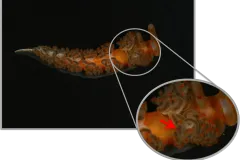How Sea Slugs Steal the Defenses of Their Prey

Not all slugs (snails without shells) are slimy brown pests found in your backyard garden. In the ocean they come in a huge variety of colors—some match the background and are hard to spot, but others are very conspicuous. Nudibranchs in particular are especially popular with divers and underwater photographers because of their often vibrant and beautiful color patterns. The coloration is useful for more than just a pretty photo, however. Bright colors warn predators that these nudibranchs would make a bad meal because they are armed with toxins and other defenses.
Where do these defenses come from? Some species within the group of nudibranchs called aeolids (pronounced eh-o-lids) steal the defenses of the stinging animals they feed on! Jellyfish, sea anemones, corals and their relatives in the phylum Cnidaria capture food with special stinging cells called cnidocytes, which line their tentacles. These venom-filled cells discharge tiny harpoon-like structures (called nematocysts) that are used to both capture prey and defend against would-be predators. Nematocysts are extremely effective in deterring most predators of cnidarians—but some predators, like aeolid sea slugs, are able to not only defeat the venomous weapons, but also use these defenses to their advantage.
When aeolids feed on these well-armed prey, the first thing they have to do is prevent the stinging cells from firing. They seem to do this using their slug slime: certain chemicals in their slimy mucus trail protect them from getting stung. Once ingested, the unfired nematocysts pass through the nudibranch's digestive tract. Some are excreted with the rest of the nudibranch's waste, but the immature stinging nematocysts are stored in pouches called cnidosacs until they have matured and are needed.
Aeolid slugs will then shoot out the stolen stinging cells when threatened, and the nematocysts sting and damage animals that try to eat the slugs. As a researcher at the Smithsonian and University of Maryland, I am looking at the evolutionary process that has allowed nudibranchs to steal and store cnidarian nematocysts. How exactly the ancestors of these slugs managed to coopt the defenses of their prey for their own use is still a mystery. Learning more about the evolutionary history of these colorful sea slugs will show us how the aeolids acquired this function and where the ability came from.

